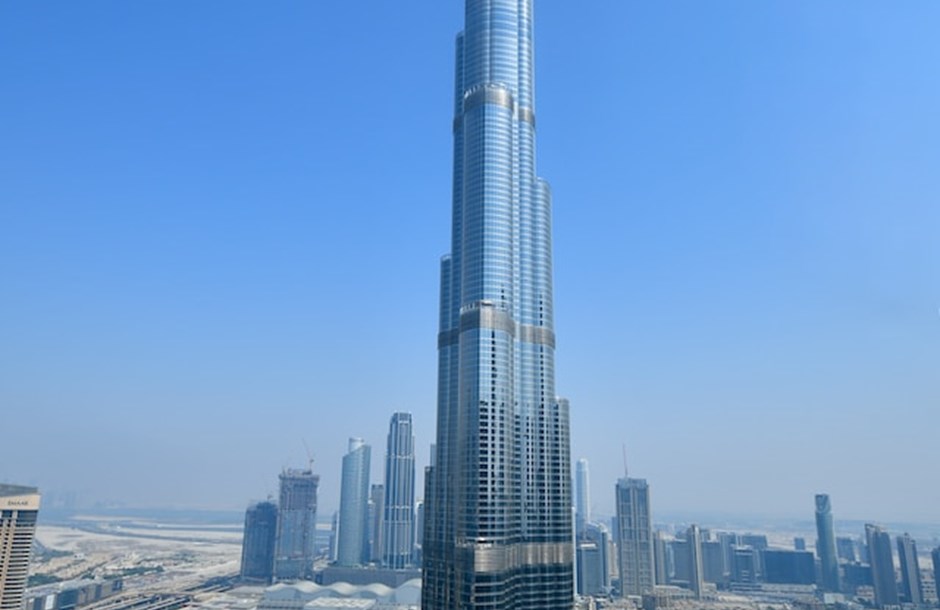Iconic construction projects – Burj Khalifa

The 828-metre Burj Khalifa skyscraper in Dubai is the world’s tallest building. Composed of 160 storeys, it is also the tallest free-standing structure in the world. Find out how this incredible structure was built, how long it took and what challenges the architects and construction team faced.
Where is Burj Khalifa?
Burj Khalifa is in Dubai, the United Arab Emirates.
When did construction start on Burj Khalifa?
Construction on the world’s tallest building began in January 2004.
Planning and design
Design & architectural features
The building was designed by the renowned super skyscraper architects, the US-based Skidmore, Owings & Merrill, with Adrian Smith the consulting design partner. The tower has a Y-shaped footprint around a central core, which gives the building stability. Its design is inspired by Islamic architecture, most notably the Great Mosque of Samarra. The cross section of the tower decreases as the structure gets taller, echoing the design of spiral minarets.
The Y-shaped wings of the building’s footprint are also intended to replicate the petal structure of a regional desert flower, the Hymenocallisor SpiderLily.
Design & planning challenges
Construction of the tallest building in the world posed some immense challenges. One of the most significant was the soil composition of Dubai. Loose sandy soil does not make for strong foundations, especially for a tower half a mile in height. This was resolved by the team’s structural engineer with the insertion of 194 friction piles 50 metres below the surface, which meant the building could ‘settle’ during construction within safe limits.
Innovation & technology
How does this supertall structure resist wind? Burj Khalifa can withstand sandstorms with wind speeds of up to 220kph by having additional piles inserted in the foundations which act like glue. The building still sways in high winds – at its very highest storeys you might experience up to two metres of movement – but is entirely safe. The building’s tapering design also helps with wind dynamics.
The construction process
Timeline & milestones
- January 2004 – excavation started
- March 2005 – construction of superstructure begins
- June 2006 – construction reaches Level 50
- January 2007 – Level 100 reached
- April 2008 – Level 160 reached
- September 2009 – exterior cladding completed
- January 2010 – Burj Khalifa officially opened.
Construction methods & materials
The tower is constructed using a lateral load resisting system, a form of construction that used reinforced concrete ductile core walls linked to the exterior reinforced concrete columns. Extensive testing was undertaken to ensure the concrete mix met durability standards, water penetration tests and had the right mechanical properties.
Concrete, glass and stainless steel are the main building materials. Among the materials used were 35,000 tonnes of structural steel from the former East German parliament building in Berlin.
Challenges faced during construction
A special mix of concrete had to be made that could absorb the weight of the building – about the same as 100,000 elephants – and be able to withstand the extreme heat of the UAE. Ice was added to the wet concrete and it was poured during the night. Concrete cures more evenly when it is cooler and is less likely to crack.
Burj Khalifa sustainability features
Sustainability was central to the planning and design of the building. One of its leading environmental features is the way it saves water from its air conditioning system and redistributes it for land irrigation and the building’s showpiece fountain. 15 million gallons of water is recycled in this way every year. Solar panels are also used to heat the water supply for the residents of Burj Khalifa.
How much did Burj Khalifa cost to build?
The project cost $1.4 billion in total. The building’s name has a financial story to tell. The tower was originally going to be called ‘Burj Dubai’, but changed its name when the President of the UAE, Khalifa bin Zayed Al Nahyan, lent the client the funds needed to complete the project.
When did Burj Khalifa open?
Burj Khalifa opened in January 2010, as the flagship building of the new Downtown Dubai development. It has 24,348 windows, 57 elevators, covers 460,000 square metres and when it opened had the highest observation deck in the world (452m).
Inspired by what you’ve read? Discover over 170 construction careers
Working abroad on projects like Burj Khalifa can be a great opportunity, and encompasses almost every job role in the construction industry. These are just a few:
If you find iconic buildings or projects like this, Wembley Stadium or the Shard exciting, and want to get into construction, Go Construct has information on over 170 job profiles available in the construction industry.
